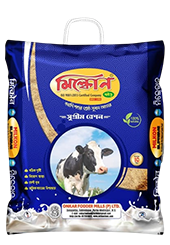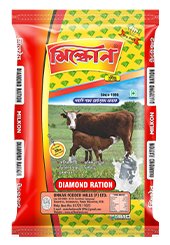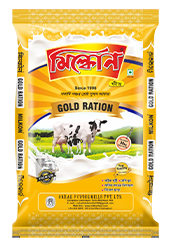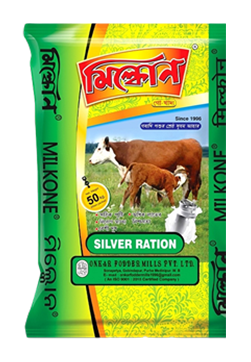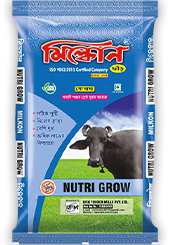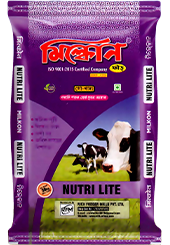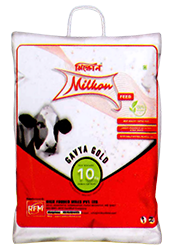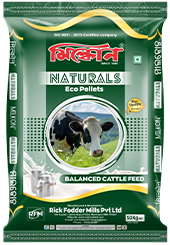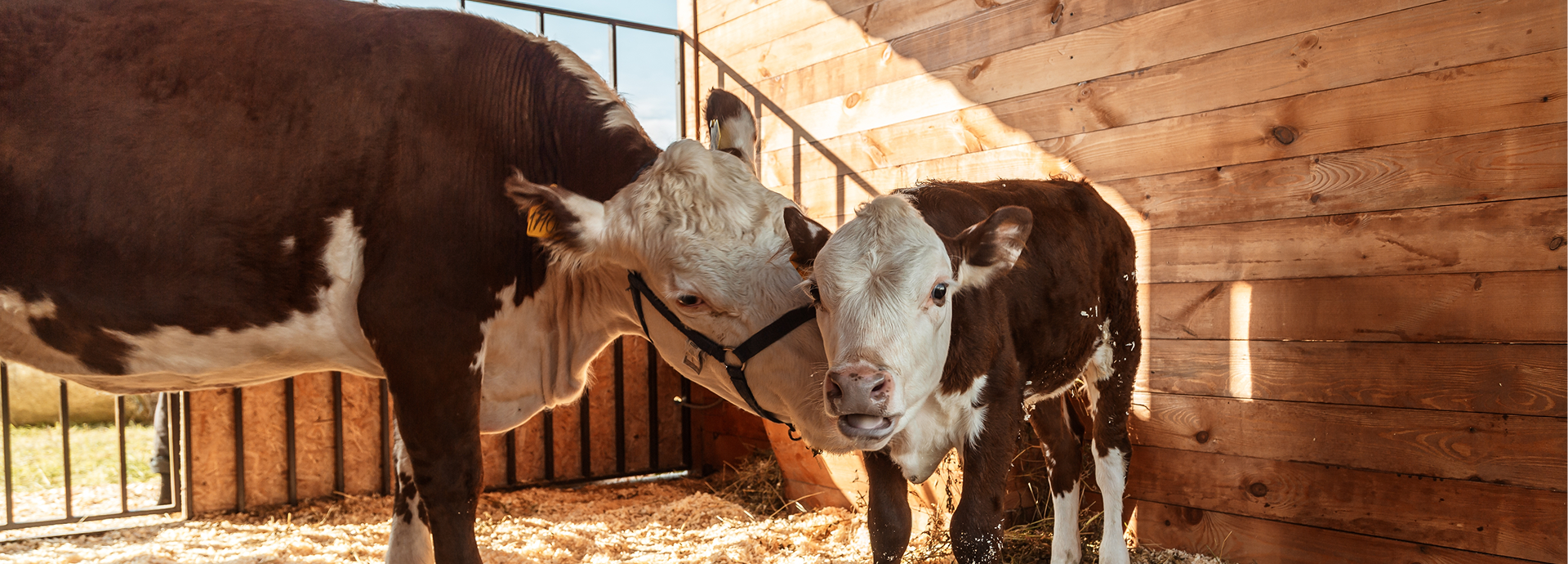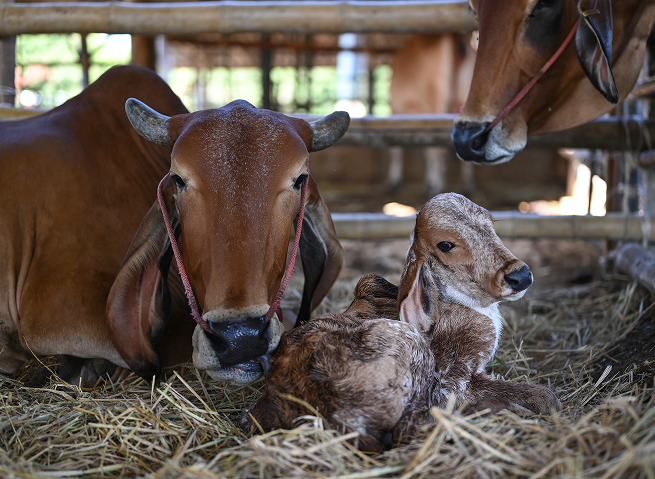
Best Balanced Feed for Cows and Calves

Unparalleled in increasing milk production, maintaining nutrition, and improving health
Phone Numbers:
- Nutritious Feed
- Care for Pregnant Cows
- Milk Fever (Hypocalcemia) – Preventive Treatment
- Artificial Insemination (AI) Timing
- Maggot Wound or Injury Treatment
Nutritious Feed
Feeds that contain energy-producing carbohydrates, body-building proteins, and elements that increase milk production and improve body function—such as calcium, phosphorus, vitamins, minerals, salt, and more—are considered “Nutritious Feed.” Like Milkon feed, which has proven for the last 15 years to be highly effective in increasing milk yield, maintaining health, and ensuring the nourishment and productivity of dairy cattle.
Daily Feeding Amount for Cows
| Condition | Indigenous Cow | Crossbreed Cow |
|---|---|---|
| For Body Maintenance: | ||
| Without work (no plowing) | 4 kg | 8–10 kg |
| With work (plowing, etc.) | 10 kg | 10–20 kg |
| Grazing only | 2–2.5 kg | 3–4 kg |
| Pregnant cows (last 6 months) | Additional 1 kg | Additional 1–2 kg |
| For Milk Production: | ||
| Per litre of milk produced | 0.5 kg per litre | 1 kg per litre |
Notes:
- For every 1 kg of feed, 10 kg of green grass or 6 kg of dry fodder (hay, straw, maize stalks) should be given.
- Cows must drink sufficient clean water:
- 4–5 liters per litre of milk produced
- For cows producing up to 8 liters: 30–40 liters
- For cows producing more than 8 liters: 40–70 liters
Care for Pregnant Cows
Feeding Guidance:
Before and after 15–20 days of calving, feed 2 kg of Milkon daily to support recovery and milk production.
Post-Calving (After 15–20 Days)
- Injection Mifex – 450 ml (1 bottle)
➤ Administer 225 ml subcutaneously every alternate day (EAD) × 2 doses - Injection Tonophosphan – 30 ml (1 vial)
➤ Administer 10 ml intramuscularly every alternate day (EAD) × 3 doses
Supplements and Veterinary Care
- Metho-Chelated Mineral Powder (Nutricell) – 1.25 kg
or
Minfa Gold – 1.2 kg
➤ Dosage: Once daily
Deworming Schedule
1–2 Months After Calving:
- Panacur (1.5 gm) – 1 dose
or Bolus Axefendol (2.2 gm) – 1 bolus at night
Within 3–4 Months After Calving:
- Injection Calborol – 450 ml (1 bottle)
➤ Administer 225 ml subcutaneously EAD × 2 doses - Injection Hivit – 30 ml (1 vial)
➤ Administer 15 ml intramuscularly EAD × 2 doses
For Milk Production Support
- Milkical Plus – 1 litre
+ Masticare Powder – 60 gm × 2 packets
OR
- Ossomin – 450 ml with 4.5 litres of water
➤ Alternatively, 1 litre of Ossomin can be given daily (30–40 ml each time)
Additional Advice
- If the cow does not conceive within 6 months after calving or suffers repeated abortions, consult a qualified veterinarian.
- If not pregnant within 8–10 months, infertility treatment is recommended.
Milk Fever (Hypocalcemia) – Preventive Treatment
To prevent milk fever (hypocalcemia), administer Metabolite Powder at a dosage of 50 gm twice a day for 20 days. The standard requirement includes:
- 50 gm × 2 times a day
- 20 packets per box × 2 boxes (total 40 doses)
If the cow weighs between 250–255 kg, begin feeding 20 days before calving to maintain proper calcium balance and prevent hypocalcemia symptoms during the post-calving period.
Treatment for Foot Rot or Swollen Legs
If the cow shows symptoms of foot rot or leg swelling, use one of the following treatment options:
Option 1: Injection Parid or Hitek
- Dosage: 1 ml per 50 kg body weight
- Route: Subcutaneous
- Repeat: After 5 days
Option 2: Injection Acety Larsan
- 10 ml ampoule
- Dosage: 10 ml intramuscular
- Frequency: Every alternate day (EAD)
- Repeat: 2–3 doses
⚠️ Note: Injection Acety Larsan should not be used during pregnancy.
Artificial Insemination (AI) Timing
For cows, insemination should be done 12 hours after signs of heat appear.
For buffaloes, the ideal time is 16–18 hours after heat signs (as per standard veterinary guidelines).
⚠️ Note: If there is any abnormal discharge (e.g., bloody or pus-like), consult a veterinarian before insemination.
Deworming Schedule & Medicines
| Dose | Age of Calf | Medicine & Dosage |
|---|---|---|
| 1st | 21–30 days old | Panacur – 150 mg, 1 tablet |
| 2nd | 2 months | Albendazole – 200 mg, 1 tablet |
| 3rd | 3 months | Panacur – 150 mg, 1 tablet |
| 4th | 4 months | Distodin – 200 mg, 1 tablet |
| 5th | 5 months | Rafox Plus – 1 ml per 2 kg body weight |
| 6th | 6 months | Valbazen – 600 mg, 1 tablet |
Note: Cows should be dewormed regularly every 3–4 months.
Important: Deworming should only be done after confirming the animal is not pregnant.
Proper Calf Rearing Practices
- Clean the calf’s nose and mouth immediately after birth, and dry the body with a clean cloth.
- Cut the navel 2 inches from the base using a sterile blade and apply tincture iodine.
- Feed colostrum (first milk) within 3 hours of birth — essential for immunity.
- Colostrum amount: 10% of calf’s body weight. E.g., a 20 kg calf should get 2 kg of colostrum per day.
- From 15 days to 2 months, provide clean, soft grass and a little Milkon feed daily.
- Maintain a clean, dry shelter to prevent maggot infestation in the navel.
- To prevent diarrhea or digestive issues: give Steclin Bolus – ½ bolus daily for 3 days.
If the Calf Appears Weak or Pale
Feed Viselam or Recovit Syrup – 20 to 25 ml twice daily.
⚠️ Note: Always consult a certified veterinarian before giving any medication.
Artificial Insemination (A.I.) – Nutrition Precautions
- Do not feed stale or spoiled feed.
- Poor nutrition may result in failed insemination or poor fetal development.
- Check cows that have stopped milking and are not pregnant after 90–120 days of calving.
- Generally, cows should conceive within 15–18 months of age.
What to Do When the Cow Doesn’t Conceive
a) Before Insemination – Deworming Medicines
- Nii3an – 100 ml
- or Panacur (1.5 gm) – 2 bolus
- or Distodin (1 gm) – 3 bolus (for 300 kg body weight)
b) After 3 Months – Pregnancy Diagnosis (P.D.)
At 3–4 months, administer one of the following dewormers:
- Rafox Plus – 100 ml per 200 kg body weight
- or Suprazole – 1 Bolus (3 gm)
- or Albomar Suspension – 90 ml
- or Axefendol Bolus – 2.2 gm, 1 bolus
c) At 6 Months (If A.I. Failed)
- Inj. Calborol – 450 ml × 1 bottle, 225 ml subcutaneous, weekly × 2
- Inj. Hivit – 30 ml × 1 vial, 15 ml intramuscular, weekly × 2
- Milkimin Forte Chelated or Agrimin Forte – 25 mg once daily
d) At 8 Months
- Inj. Mifex – 450 ml × 1 bottle, 225 ml subcutaneous, weekly × 2
- Inj. Lavitone-H or Intavita-H – 5 ml intramuscular, weekly × 3
Vaccination Guidelines
- FMD vaccine is safe for pregnant animals.
- Do not give the vaccine to calves younger than 2 months.
- To protect young calves, vaccinate the pregnant cow during her 7–8 month of gestation to build resistance in the calf.
Treatment
There is no specific treatment for viral diseases. Only symptomatic treatment should be administered as per veterinary guidance.
a) Hoof Care
- Wash hooves with potassium permanganate or normal saline.
- Do not use dressing oil, as it prevents proper drying.
- Apply Himax, Charmil, Lorexane, or Acrilin ointment.
- If severely infected, use antibiotic spray and bandage the area.
b) Mouth Treatment
- Wash mouth with fitkari (alum) water.
- Apply Candid mouth paint or glycerin-boric acid solution.
- Feed Mofulog, Harbune, or Apthocare Powder – ½ packet twice daily (oral).
c) Fever, Swelling, Wounds, or Complications
- Inj. Zobid-M / Melonex – 10–15 ml intramuscular daily × 3 days
- Inj. Munomycin Forte – 2.5 gm intramuscular daily × 3 days
(or Dicrysticm-S – not for pregnant animals)
OR - Inj. Enrocin – 15 ml intramuscular daily × 3 days (Not safe during pregnancy)
- Inj. Lemasol – 1 ml per 30 kg body weight (e.g., 10 ml subcutaneous, EAD × 3–5 days)
Boosts immunity and is safe during pregnancy - Inj. Brivit – 5–10 ml intramuscular, twice a week × 4 doses
- Oral calcium: Ossomin Vet, Calshakti, or Orcal-P
- Inj. Chloril Vel / Anistamin – 5–10 ml daily × 3–5 days
Cleanliness & Hygiene
- Maintain strict hygiene in the cattle area.
- Clean the affected area 2–8 times daily with disinfectant.
⚠️ Caution: Poor hygiene can lead to severe infections and may result in calf death.
Maggot Wound or Injury Treatment
Wounds can get infested by maggots due to fly eggs, causing severe tissue damage. Apply Butox or Clinar (5 ml) thoroughly in and around the wound. Follow with dressing oil, Himax, or Topicure ointment for better healing.
Ectoparasite Treatment (Lice, Ticks, Mites)
Lice and ticks cause itching and blood loss. If untreated, it may result in anemia and weakness.
- Bayticol (30 ml): Apply along the spine. Do not bathe for 24–48 hours.
- Clinar / Butox: Mix 5–15 ml in 1 liter of water and apply over the body. No bathing for 24–48 hours.
- Inj. Parid / Hitec: 10 ml, 1 ml per 50 kg body weight, subcutaneously.
Important Note on Pregnant Cows
Fever above 106°F in pregnant cows can lead to abortion. Risk increases with viral diseases like FMD, Ephemeral fever, Babesiosis, and IBR.
When the Cow Doesn’t Come into Heat (Anestrus)
If the cow does not conceive by 18 months or within 90 days post-calving:
- Ovary massage for 2–3 days
- Deworming as per vet’s advice
- Lavitone-H / Intavita-H: 5 ml IM weekly × 4–6
- Cyclomin / Minotas: 1 tablet daily × 20 days
In Case of Diarrhea
- Calves: ½ tablet twice daily
- Heifers: 1 tablet twice daily
- Cows (300 kg): 2 tablets twice daily
Summer Care Tips
- Do not provide spoiled or warm food. It can cause fatal food poisoning.
- Protect animals from prolonged sun exposure. Provide shade for pregnant cows.
- Ensure clean water and nutritious feed, especially after delivery.
Homeopathic Treatment
1. For Safe Delivery
Cimicifuga (200): 1 dram – 5 drops daily from 8th to 10th month of pregnancy.
2. Foot Rot or Hoof Cracks
- Graphitis (200): 5 drops daily × 10–15 days
- Graphitis (1M): 5 drops weekly × 2 weeks
- Calendula (Q): Mix with water + Dettol, apply 1–2 times daily
- Fluoric Acid (200): 5 drops every 2 days × 1 week
3. Other Conditions
- Natrum Mur (200): Uterus not contracting
- Pulsatilla (200): Delayed delivery
- Acid Mur (200): Uterine prolapse
- Podophyllum (200): Rectal prolapse
- Phytolacca (200): Hardened udder
- Marc Sol (30/200): Mild pneumonia
- Colocynth + Marc Cor (200): Severe pneumonia
4. Repeat Breeding
- Sabaina (200): 1 dram – before/after 4th A.I.
5. Calf-Related Remedies
- Katherium (30): Prevent disease
- Falticium (30/200): Digestion
- Carboveg (30/200): Cough/cold
- Rhus Tox (30/200): Contaminated water
- Calcarea Phos (30): Milk digestion
6. Failed Conception Post-Insemination
- Millipholeum (200): 1 dram – 5 drops twice daily × 7 days

